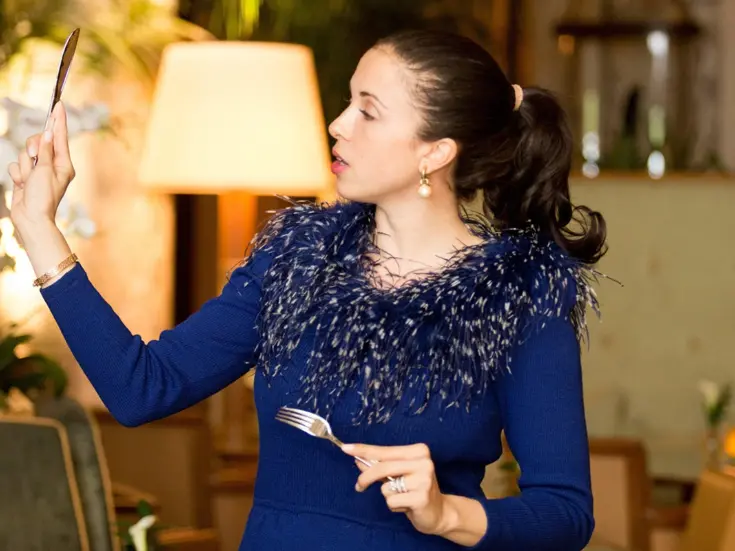
Never Mind the Bolshoi
It has survived Tsars, fires, Lenin and Putin, but Moscow’s revamped Bolshoi Theatre’s biggest challenge may be its glamorous yet conservative and extremely talkative audiences, says Teresa Levonian Cole
STANDING BETWEEN A determined statue of Lenin and the colossus of the Novosibirsk Opera and Ballet Theatre, my middle-aged guide was lamenting the demise of Communism and, with it, generous funding for the arts, commitment to universal education, and affordable tickets for all.
‘Yuri Grigorovich said he preferred our company’s performance of his Spartacus ballet to the Bolshoi’s own,’ she continued proudly as we toured the theatre. ‘And we make stage sets for the Bolshoi here, because they lack the space.’
Designed to accommodate choreographed tanks for military parades (when vacated by consumptive Mimis and amorous Rodolfos), there are, in truth, few theatres in the world that can boast the amplitude of Novosibirsk’s stage. This is just one of the dozens of grand opera houses built during the 1930s, dedicated to informing and uplifting the proletariat, all the way to remotest Ulan-Ude in the Siberian wastes of Buryatia.
In the interests of education, repertoire embraced both the native and the unexceptionably foreign: no matter if the flutey coloratura roles of a Donizetti were mired in the tongue of earthy Cyrillic fricatives.

Some weeks later, I found myself in the velvet cocoon of a Grand Tier box at the Bolshoi itself, the grandest and most venerable of all Russia’s theatres. No Stalinist upstart, this.
Commissioned by Catherine the Great in the year of America’s independence (and initially known as the Petrovsky), the present building was erected by Osip Bové in 1825, was rebuilt by Alberto Cavos in 1856 after a devastating fire, and witnessed the coronation celebrations of three generations of Tsars, from Alexander II to Nicholas II, before re-opening in its current incarnation as the unifying symbol of the new Russia.
I watched the audience of some 1,720 file into the opulently restored crimson, cream and gold interior and take their seats, the spacious arrangement of the stalls belying the fact that the performance was sold out. Eventually, the glow from the two-ton chandelier and encircling crystal lights dimmed, to focus on the curtain of embroidered gold, whose USSR motif and hammer and sickle have yielded to the Romanov emblem of the double-headed eagle.
The curtain rose, an arpeggio of horns and bassoons announced the overture and, as a cue to silence, failed miserably. It took the bedroom antics of the Marschallin and Octavian (in the language Strauss intended) to hush the scraping of chairs, beeping of text messages, exegesis of the synopsis and review of the week’s gossip.
In this summer-vacationing Moscow, around half the audience was foreign. Given the amount of international media coverage devoted to L’Affaire Bolshoi, it is perhaps not surprising if a large percentage of the audience came more to gawp at what the fuss was about, than to enjoy the finer manifestations of the Dionysian spirit.
Since the theatre closed in 2005 for essential repairs, until the gala re-opening on 28 October 2011 before a Kremlin-invited audience of artists and film stars, church patriarchs and Wall Street financiers, a Sturm und Drang of delays (totalling three years), over-spend (sixteen times the original budget), accusations of embezzlement, smear campaigns, resignations, firings and assorted recriminations have engulfed the project.

Not to mention the brouhaha over ticketing — with scalpers charging many times the face value, up to $66,000 a pop for the opening night — that has led the Bolshoi to request passport ID for advance bookings. It is hard to know whether the pigeon-capped statue of Karl Marx looking on from across Teatralnaya Square would have laughed, if it could, or cried.
The Bolshoi’s grand staircase
THE TOTAL DISBURSEMENT for the federally funded repairs remains as hazy as if shrouded in dry ice. Figures quoted range from $680 million to $2.2 billion, swallowed up by gargantuan structural, acoustic and decorative works to reverse damage wrought by time and shoddy Soviet-era alterations that involved the liberal use of concrete.
(Lenin, incidentally, had wanted to demolish the theatre, but Stalin — despite his desecrations — rather liked the place, raising the salary of artists to ministerial levels).
In 2009, meanwhile, the General Prosecutor’s Office launched a criminal investigation into fraud worth millions of roubles by one of the contractors. Things looked up, as then President Medvedev was prevailed upon to establish a federal agency to oversee the warring factions involved. ‘The condition [of the Bolshoi] was not just critical, it was catastrophic,’ said Mikhail Sidorov, spokesman of Summa Capital, the newly appointed development company. The building was deemed 70 per cent unstable ‘and could collapse in parts or completely’.
According to general director Anatoly Iksanov, who heroically weathered these stormy years at the helm of the Bolshoi, workmen joked that the building was being held up only by the electrical wiring. Most urgently, the 30cm cracks in the walls were addressed, while the rotting oak piles that underpinned the building were removed by hand and and replaced with 7,000 temporary steel columns before excavation to create five additional underground levels that double the area of the theatre.
Attempts to restore acoustics to the Imperial sonority included the removal of concrete which had been poured into the resonant hollow beneath the orchestra pit. Floors were replaced with wood, 19th-century reflective spruce panels were re-created, acoustic-friendly materials reintroduced, additional seating stripped out, and the rumble of the underground Metro silenced.
At the same time, conditions for artists and technicians were dramatically improved. The orchestra pit was extended to accommodate 130 musicians, enabling the performance of Wagner’s and Strauss’s operas. Two separate stage surfaces were created for opera and ballet — the former sound-reflecting, the latter sound-absorbing — the backstage area expanded and the highest of hi-tech equipment installed.
Modern wizardry, however, proved no match for medieval know-how when it came to the decorative elements. Ingredients that might have figured in an alchemical text — glue made from tea leaves and sturgeon guts; primer concocted from whale grease, vodka and warmed egg-whites — were deployed to magical effect.
Dazzling statistics were released. As many as 956 skilled gilders, embroiderers, craftsmen and restorers worked on site at one time, with a further 2,000 labouring in studios; some 4.5kg of sound-reflecting gold leaf applied to restored papier-mâché mouldings and arabesques; Venetian mosaics, based on a few unearthed fragments, duplicated for the circular corridors; three years spent re-creating 820 yards of cloth on ancient looms, to match a rediscovered swatch; 24,000 drops of crystal polished, restored and rehung on the 28-foot-tall chandelier… The list goes on.
‘Basically, everything front of house is restored to its former state, while everything backstage is reconstructed,’ says Bolshoi spokesperson Katerina Novikova of the controversy centring on the Russian predilection for the gleaming faux-historic.
While Unesco approves the outcome of this Herculean labour, visiting artists (Placido Domingo and Daniel Barenboim among them) praise the acoustics and iconoclastic director Dmitry Chernyakov (who staged the opening production of Ruslan and Lyudmila) garners plaudits abroad, it must be galling to face a barrage of criticism on one’s own doorstep.
Arkhnadzor, Russia’s most vocal preservationist group, maintains that reconstruction, rather than restoration, within the historic monument ‘pollutes the entire building, like a tarnished spoon in a pot of honey’.

Bolshoi dancer Nikolai Tsiskaridze agrees, likening the result to ‘a hotel in Turkey that has been built in the shape of the Bolshoi’, while soprano Anastasia Meskova complains: ‘They knocked down a cathedral and put up cardboard.’ Even the vaunted acoustics are not spared: Vladimir Jurowski, who conducted the first public performance of the reopened theatre, slammed the sound as ‘terrible’.
The auditorium at the Bolshoi Theatre, revamped from its acoustics to its mouldings
OCCASIONALLY, CRITICISM DESCENDS into farce, for the delectation of Bolshoi-watchers. Take the Battle for Apollo’s Manhood. The giant figure of the god driving his four bronze horses atop the eight-columned neoclassical portico, desalinated and magnificently restored, is familiar to Muscovites — but for one embellishment.
‘Why has he been given a fig leaf?’ demands one camp. ‘Apollo was originally covered — but the leaf fell off during Communist times,’ insist the restorers somewhat improbably. Then there’s the woman who demanded a million roubles’ compensation for ‘the moral agony’ of watching Glinka’s opera invested, in Chernyakov’s production, with ‘vulgar sex scenes’. Result: no million, but an X-rating appeared on the theatre’s poster.
Absurd as it may be, this incident reveals a fundamental dilemma facing the Bolshoi: the conservatism of its audiences, both in terms of production and repertoire.
While the management strives, in the words of Anatoly Iksanov, for ‘integration in a global opera context’ through prestigious new commissions, contemporary productions and joint ventures with leading international companies, the Russian aesthetic remains resolutely rooted in the 19th century. And with some 40 per cent of revenue now deriving from sponsorship and the box office, it is a brave theatre that risks alienating its audience.
‘We are of course relieved that the restoration is finally complete, and delighted that the Bolshoi, and opera generally, inspire such passionate debate,’ says Katerina Novikova with a wry laugh. And so, for the time being, are the touts on Teatralnaya Square.
Read more from Teresa Levonian Cole
Read more on travel
Don’t miss out on the best of Spear’s articles – sign up to the Spear’s weekly newsletter
[related_companies]







